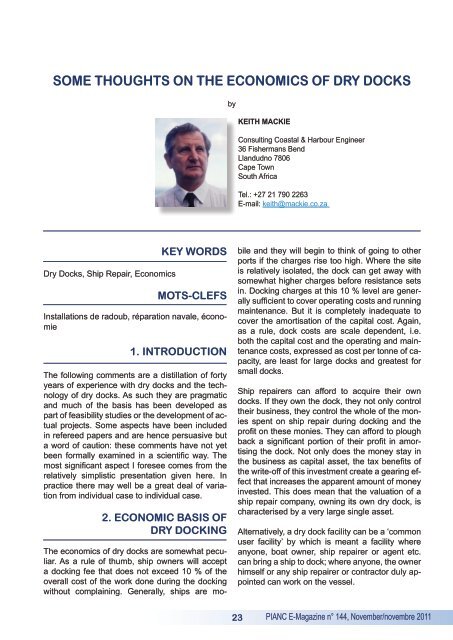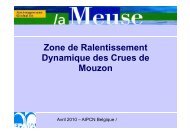PIANC E-Magazine - PIANC AIPCN welcome
PIANC E-Magazine - PIANC AIPCN welcome
PIANC E-Magazine - PIANC AIPCN welcome
Create successful ePaper yourself
Turn your PDF publications into a flip-book with our unique Google optimized e-Paper software.
Some Thoughts on the Economics of Dry Docks<br />
by<br />
KEITH MACKIE<br />
Consulting Coastal & Harbour Engineer<br />
36 Fishermans Bend<br />
Llandudno 7806<br />
Cape Town<br />
South Africa<br />
Tel.: +27 21 790 2263<br />
E-mail: keith@mackie.co.za<br />
Dry Docks, Ship Repair, Economics<br />
KEY WORDS<br />
MOTS-CLEFS<br />
Installations de radoub, réparation navale, économie<br />
1. INTRODUCTION<br />
The following comments are a distillation of forty<br />
years of experience with dry docks and the technology<br />
of dry docks. As such they are pragmatic<br />
and much of the basis has been developed as<br />
part of feasibility studies or the development of actual<br />
projects. Some aspects have been included<br />
in refereed papers and are hence persuasive but<br />
a word of caution: these comments have not yet<br />
been formally examined in a scientific way. The<br />
most significant aspect I foresee comes from the<br />
relatively simplistic presentation given here. In<br />
practice there may well be a great deal of variation<br />
from individual case to individual case.<br />
2. ECONOMIC BASIS OF<br />
DRY DOCKING<br />
The economics of dry docks are somewhat peculiar.<br />
As a rule of thumb, ship owners will accept<br />
a docking fee that does not exceed 10 % of the<br />
overall cost of the work done during the docking<br />
without complaining. Generally, ships are mobile<br />
and they will begin to think of going to other<br />
ports if the charges rise too high. Where the site<br />
is relatively isolated, the dock can get away with<br />
somewhat higher charges before resistance sets<br />
in. Docking charges at this 10 % level are generally<br />
sufficient to cover operating costs and running<br />
maintenance. But it is completely inadequate to<br />
cover the amortisation of the capital cost. Again,<br />
as a rule, dock costs are scale dependent, i.e.<br />
both the capital cost and the operating and maintenance<br />
costs, expressed as cost per tonne of capacity,<br />
are least for large docks and greatest for<br />
small docks.<br />
Ship repairers can afford to acquire their own<br />
docks. If they own the dock, they not only control<br />
their business, they control the whole of the monies<br />
spent on ship repair during docking and the<br />
profit on these monies. They can afford to plough<br />
back a significant portion of their profit in amortising<br />
the dock. Not only does the money stay in<br />
the business as capital asset, the tax benefits of<br />
the write-off of this investment create a gearing effect<br />
that increases the apparent amount of money<br />
invested. This does mean that the valuation of a<br />
ship repair company, owning its own dry dock, is<br />
characterised by a very large single asset.<br />
Alternatively, a dry dock facility can be a ‘common<br />
user facility’ by which is meant a facility where<br />
anyone, boat owner, ship repairer or agent etc.<br />
can bring a ship to dock; where anyone, the owner<br />
himself or any ship repairer or contractor duly appointed<br />
can work on the vessel.<br />
23<br />
<strong>PIANC</strong> E-<strong>Magazine</strong> n° 144, November/novembre 2011




